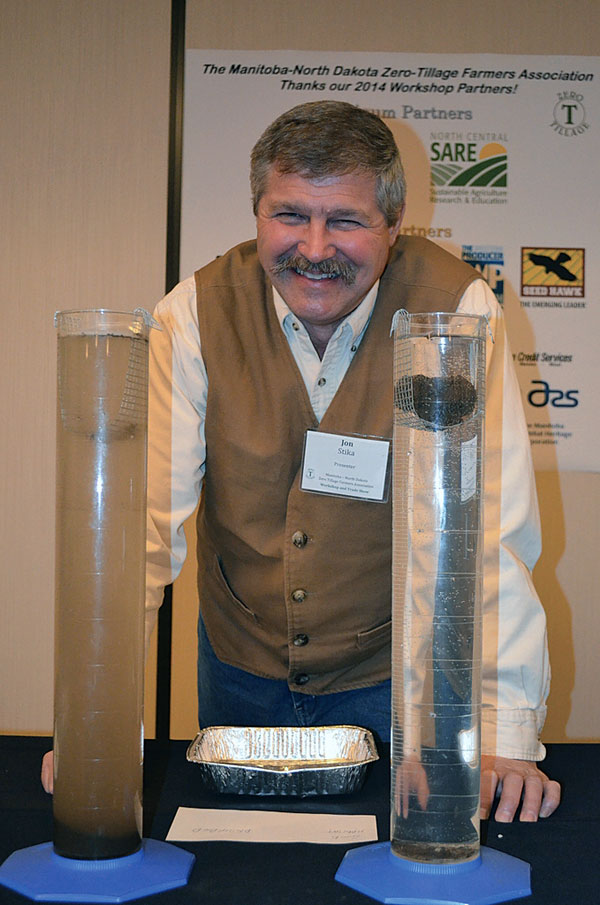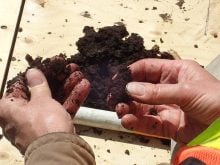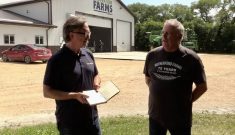Jon Stika says farmers always give the same answers when asked what they want from their soil. “They want it to grow crops, infiltrate water and supply nutrients,” the USDA soil scientist told last week’s annual workshop of the Manitoba-North Dakota Zero Tillage Farmers Association.
“But what if we managed it to its fullest potential, then what could it do? Then how efficient and profitable could we be?” Stika asked.
Achieving that requires looking at soil as a living ecosystem made up of not just silt, sand and clay, but also the microscopic critters that are equal in mass to two cows per acre.
Read Also

What is perfect Christmas weather?
What is ‘perfect’ Christmas weather on the Prairies? Here’s where you should head this holiday, according to historical weather data.
“Ninety per cent of what you expect the soil to do is based on what lives in the soil,” said Stika.
Changing management practices — or being nice for a change — is the simplest way to do it, he said.
“It’s like if you took someone and every morning shoved them head first down a flight of stairs and didn’t give them breakfast,” said Stika.
“How much work could they get done with one arm in a sling, an eye swollen shut, and limping?”
It’s basic economics. Increased profit margins are the result of higher productivity without the need for additional inputs.
Park the tillage tools
Parking the tillage tools is a good first step towards “creating quality microbial habitat.”
As proof, he cited research from North Dakota State University that shows avoiding soil disturbance under long-term no till offers a free 50-pound nitrogen credit for every crop year.
“That’s 20-some bucks a year on how many thousands of acres? You’re starting to talk some serious money here,” he said.
Most plants leak out between 30-50 per cent of the sugars they create via photosynthesis via their roots to feed those two underground “cows.”
Planting diverse crop rotations and cover crops provides a more nutritious diet for the first level of the nutrient-cycling soil food web. When the biological system thrives, it results in better water infiltration rates, improved phosphorus availability via fungal networks in the soil, and reduced disease pressure by fostering balanced “predator-prey” relationships between the soil organisms.
From the Grainews website: Sclerotinia in Manitoba
Soil terminology
Academics, crop consultants and farmers all use different terminology to describe healthy soil, but it all boils down to aggregation, organic matter and soil biology, said Abbey Wick, a soil health specialist from North Dakota State University.
The most obvious indicator of soil health is aggregation, or clumping into units large and small. But “functionality” — the presence of living roots, bugs, bacteria, and fungi — is where the payoff comes in terms of water-holding capacity, erosion resistance, and crop yields.
Wick said aggregates create pore spaces for roots to develop into, and crops that can reach further into the soil profile always perform better than those that are restricted.
Air spaces between soil aggregates supply oxygen to soil flora and fauna that recycle crop residues into mineralized, plant-available nutrients, allow the soil to warm up more quickly in spring and drain off surface water to prevent surface ponding, Wick said.
Earthworms create aggregates through their digestion, and protozoa and nematodes “graze” on bacteria and fungi to release the nutrients bound up in their cellular biomass.
“This is something I find fascinating: within an aggregate, you have different microbial functions than you do on the exterior,” said Wick, adding that the “food web” or “grazing” that occurs in the soil is important for soil health and therefore crop yields.
Kris Nichols, a USDA soil microbiologist based at Mandan’s Northern Great Plains Research Laboratory, said that a growing plant can have all the chemical nutrients it needs in the soil, but without the micro-organisms to make them available it is like a shipwrecked survivor surrounded by “water, water, everywhere, and not a drop to drink.”
“That’s the role that micro-organisms play: to make that stuff plant available so that we don’t have to add those nutrients to our soil systems,” said Nichols.
In her presentation, she made a case for rethinking the soil testing process. Currently slanted towards “in-out” chemistry, Nichols argued that such a narrow focus neglects the importance of soil biology’s symbiotic relationships, as well as physics and even geology in crop production.
“What I’m trying to explain is that we don’t know it all. In fact, we don’t know very much at all,” said Nichols.
Cutting-edge science shows that soil productivity is based on “multi-layered interactions” that are very difficult to measure.
Understanding what goes on in the soil is akin to exploring an alternate universe, but the need for new perspectives that go beyond “bench-top chemistry” is being driven by the changing dynamics of global economics, energy and nutrient input availability, she added.















